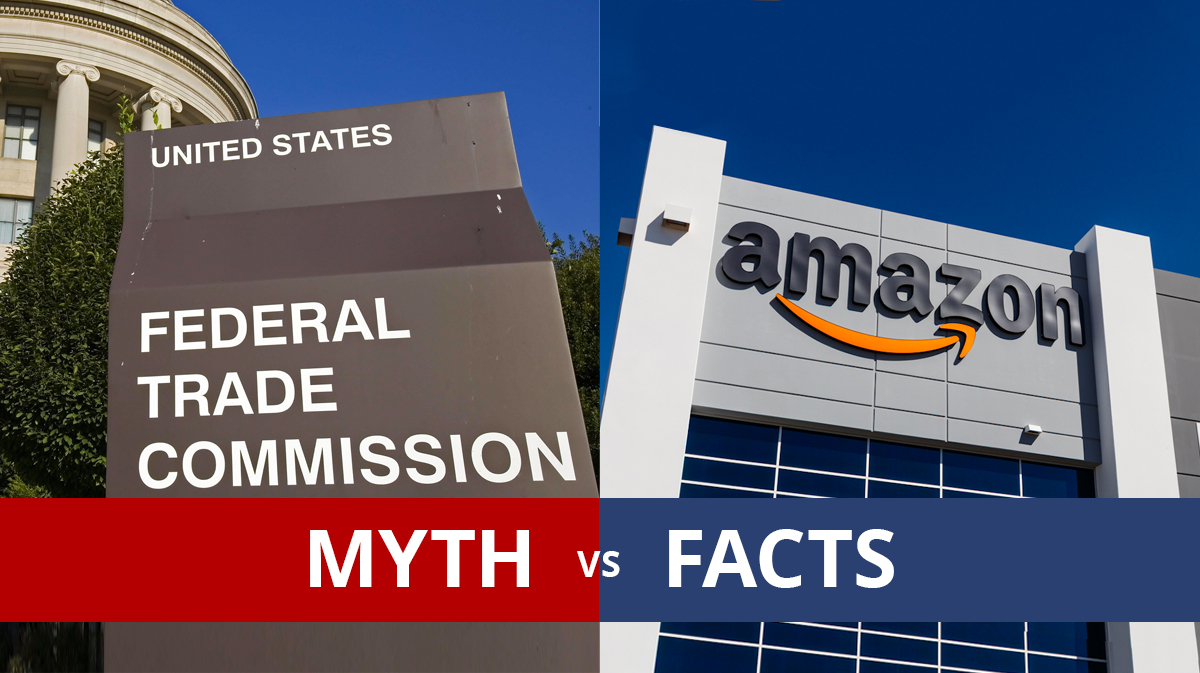
Myth v Fact: Misconceptions and False Premises in the FTC/Amazon Lawsuit

FTC Myth: [Amazon is] Charging costly fees on the hundreds of thousands of sellers that currently have no choice but to rely on Amazon to stay in business. These fees range from a monthly fee sellers must pay for each item sold to advertising fees that have become virtually necessary for sellers to do business. Combined, all of these fees force many sellers to pay close to 50% of their total revenues to Amazon. These fees harm not only sellers but also shoppers, who pay increased prices for thousands of products sold on or off Amazon.

- The FTC is only looking at the cost side of the equation and ignoring the value Amazon provides sellers.
- No matter where they sell their products, businesses always have expenses to cover. Sellers must acquire inventory, store it, attract customers, build their brand, deliver products, address customer concerns, and handle returns. Brick-and-mortar retailers must pay rent for their physical locations, while wholesalers receive only a portion of the retail price. Online sellers must pay for advertising across various platforms and logistics, and marketplace sellers must pay referral fees and advertising costs to attract customers and logistics expenses.
- Amazon provides sellers greater value than any other marketplace or online sales method. Sellers choose FBA because it is affordable and easy to use as a warehousing and shipping service. Sellers choose to Advertise on Amazon because it drives sales and measurable, high-performing ROI.
- Amazon’s value is significantly higher than the typical wholesale/retail relationship, where buyers at large stores control access to the shelves and customers, and markups can range from 60-400% and are typically paid less than selling through Amazon.
- However, modern retail is still incredibly diverse, and the idea that sellers have “no choice” but to rely on Amazon is preposterous.
- Small sellers’ two most popular sales methods are still “Brick and Mortar” retail stores (79%) and Wholesale (78%), followed by online marketplaces (68%) and company-owned webstores (68%).
- 100% of SMB Sellers using Amazon’s Online Marketplace also use at least one other sales method and 83% use five or more sales methods.

FTC Myth: Anti-discounting measures that punish sellers. For example, if Amazon discovers that a seller is offering lower-priced goods elsewhere, Amazon can bury discounting sellers so far down in Amazon’s search results that they become effectively invisible.

- The beauty of marketplaces – Amazon, eBay, Etsy, Walmart, HomeDepot, CVS, Target, and all others – is that sellers control their own inventory, pricing, shipping, warranty, and customer service. The seller does not need the marketplace’s permission to raise or lower prices or introduce new products.
- Specifically, on the Amazon marketplace, sellers always price as they choose, and sellers can match or not match their prices on other marketplaces and other sales channels.
- Amazon does not “bury” any seller or product in search results. Amazon provides the “Featured Offer” (formerly known as the Buy Box) to boost visibility for the product that the algorithm determines will best meet customers’ desires. Amazon’s goal is to sell products that make consumers happy, and it determines that in response to each search and each consumer based on a combination of competing listings’ product quality, price, delivery speed, reviews, and returns. If a seller is not competitive on any of these, including price, they are unlikely to be the “Featured Offer,” and that listing in search results will be wherever it otherwise belongs.
- A platform’s rule favoring the lowest competitive prices helps all marketplace sellers because consumers know they are getting low prices (and quality service), which becomes their first-choice retail platform. All sellers lose if customers stop trusting that a marketplace offers low prices.
- Some say that Apple abuses app publishers because it does not permit publishers to communicate with their customers about off-Apple discounts. In contrast, Amazon lets marketplace retailers put coupons or discount codes in their FBA packages for the sellers’ Shopify stores.

FTC Myth: Conditioning sellers’ ability to obtain “Prime” eligibility for their products—a virtual necessity for doing business on Amazon—on sellers using Amazon’s costly fulfillment service, which has made it substantially more expensive for sellers on Amazon to also offer their products on other platforms. This unlawful coercion has, in turn, limited competitors’ ability to effectively compete against Amazon.

- Prime is NOT a virtual necessity for doing business on Amazon. Prime offers many sellers terrific value and tremendous additional sales (because consumers trust the Prime badge). Many other sellers choose to sell without Prime or choose Prime for only some products or listings and are very happy with their sales volume.
- Sellers are not required to use FBA to qualify for Prime. FBA is frequently the easiest and least expensive way for small sellers to meet the guaranteed delivery requirements for Prime, but sellers have the option of seller-fulfilled Prime so long as they meet the required product quality, delivery speed, and customer service standards.
- Which “competitors” cannot effectively compete against Amazon due to FBA and Prime? Many sellers begin shipping with USPS, UPS, and FedEx, but they transition to FBA because (a) it is typically 30% cheaper than competitors’ standard rates, (b) it eliminates the need to hire and manage logistics, product management, warehousing, and customer service personnel, and (c) the Prime badge communicates quality and trust to consumers and sales skyrocket.

FTC Myth: [Amazon is] Degrading the customer experience by replacing relevant, organic search results with paid advertisements—and deliberately increasing junk ads that worsen search quality and frustrate shoppers seeking products and sellers who are promised a return on their advertising purchase.

- The FTC’s definition of “junk” ads that worsen search quality and frustrate shoppers and sellers is preposterous. Regardless of where they sell products, sellers must attract customers and stand out. Small sellers cannot match the budgets of established brands that advertise on TV. But, sellers gain 17% more customers and 26% more sales when advertising on Amazon. Sellers speak much more favorably about Amazon’s advertising ROI than Walmart’s or Etsy’s.
Organic search results are the results of an algorithm, and Amazon does not “replace” organic search results with ads. Ads are interspersed among organic search results just as grocers intersperse pay-for-placement products on eye-level shelves and endcaps and add “On Sale” tags to products that are on sale that week – and all these paid brick-and-mortar promotions are interspersed between other products that are “organically” on the shelves.

FTC Myth: [Amazon is] Biasing Amazon’s search results to preference Amazon’s own products over ones that Amazon knows are of better quality.

- Stores featuring their own brands and placing them next to competitive manufacturers’ products is standard retail practice. Consumers seeking low-priced products know they are making a price/quality choice, whether the store brand is Amazon Basics, Kirkland, or Walmart’s Great Value. Also, retailers have long offered up-market store brands like Nordstrom’s Caslon and Macy’s I.N.C. that compete alongside third-party brands. Amazon’s Pinzon and Solimo brands are no different.
- Customers who are shopping for name-brand goods are not going to be diverted to a store-brand product any more Amazon than when shopping in a supermarket or department store.
















